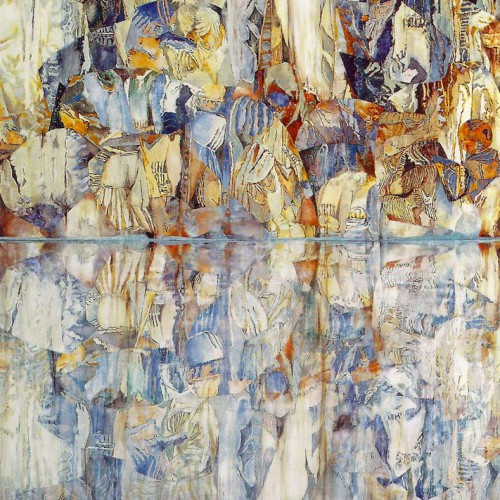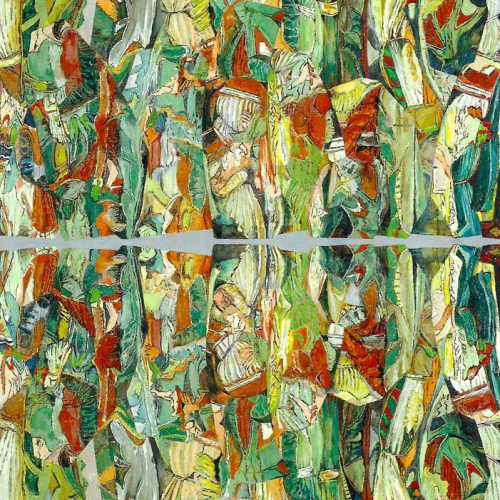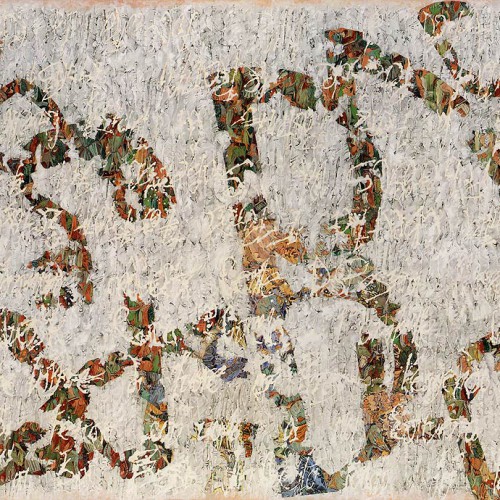John Slyce’s catalogue essay for Thérèse Oulton’s exhibition Slow Motion, 2000.
- Spectre Grey, 1999
- Palindrome, 1999
- Between the Lines, 1998
Where the microscope ends, the telescope begins.
Which of the two has the grander view?
Victor Hugo, Les Miserables, Saint Denis, Book III, Chapter 3
To float ideas in paint is a project that flirts wildly with ambition while courting near certain disaster. This has perhaps less to do with the congealed material properties of oil, acrylic, or even household paint, than it does with an honest reckoning of the accumulated baggage we carry with us during acts of reading, or indeed attempts to think contemporary thoughts within the burdened frame of painting. For Thérèse Oulton, the weight of this baggage and the limitations it tends to impose on makers and receivers is both her chosen subject and her inescapable situation.
Oulton openly recognises the dubious status painting holds in a visual culture wed to an uninterrupted production and flow of images that bombard and structure our experience of the everyday. And yet, she is committed to an art of ideas that takes place within the thickened context of painting – a frame replete with a history that exerts its own limitations and yet, in her view, continues to offer a wealth of potential sourced in the complexity of the moves and manoeuvres amassed across the history of the medium. History is, as such, a burden, but also an essential ballast that generates its own possibilities of movement.
Oulton’s work suggests a sense of potent impotence as it draws on the power of the powerless. This said, her position is not a heroic one, nor does she give service to the sentimentality of a romantic defence or conservative restoration of the status of the medium. Painting will have its heroes and villains, detractors, defilers, and defenders. However, while acknowledging their existence, she refuses to enter into the dead letter of their arguments. Her own re-engagement with the medium – one that takes in equal hands its strengths and weaknesses – is unique in its realistic assessment of the cultural terrain in which painting’s conditions of existence are grounded. In recognising that the mirror is shattered, her practice asks – what use can still be made of the shards?
Thérèse Oulton attempts to strike some sort of unity between the negative and the positive in her painting – this, in itself, being for long a defining feature of praxis. She often willfully occupies middle positions seemingly excluded by the worn dictates of irreconcilable opposites; perhaps the most tired and representative of which is that struck by the polar positions of abstraction and figuration. That painting is so freighted by an overflow of history and tradition is, for Oulton, what makes it the most fertile ground over which to spread her philosophical interests and speculations. Musical harmony involves the overcoming, but without the eliminating, of some musical opposition. Much like the counterpointed notes of a fugue, she is able to strike delicate dialectical harmonies both within individual works and across her project in this, at times, unforgiving medium. In doing so, Oulton’s work proves that out of dischord can come the fairest harmony.
Oulton has titled this exhibition of work from the years 1997-2000 ‘Slow Motion‘ and these series are a continuation of her explorations in the theme of time. Painting is conventionally understood as a fact that is comprehended in the immediacy of a glance. Perhaps the most pronounced aspect of her practice is its attempt to refute and disrupt the ways of looking such a convention sponsors. A glance is the equivalent of a passing thought that fails to take hold in the imagination and germinate into the budding of an idea. As ever, her painting is as much a mental as a visual event spread across an architecture of fractured forms and overlays of colour extended in time and memories.
Repetition features strikingly as a coneptual and material element in these new works. Oulton’s paintings are not necessarily given to free-floating contemplation – there is information embedded in them that offers, if not wholly demands, to be read creatively as a form of knowledge. Repetition itself refers to the natural world of reflections. “What is repeated”, Lacan writes, “is always something that occurs… as if by chance.” To repeat oneself is an attempt of retieval and a fundamental part of a returning search for the real. The images on these canvases are repeated through with fluctuations and permutations that exist as if they were an analogue translation of digital information. In this, Oulton’s repetitions appear to be a complication, or a distortion of something seemingly pure and perfect. The repetition in these paintings is arbitrary, but also repetitive in a deliberate or automatic sense that suggests a relationship to the mechanical world of image production. If painting can be said to have a distinct area of competence, then Oulton vacates it to enter the realm of making information visible that the image technologies of film, photography, and digital media occupy. This move exposes painting to the field of the ‘optical unconcious’ – a term first used by Walter Benjamin in his 1951 essay ‘A Short History of Photography’ and later elaborated in that decade in his ‘The Work of Art in the Age of Mechanical Reproduction’.]
In these essays, Benjamin sketched a notion of the camera as a device that could penetrate a web of unconscious optics, or those ordinary movements and motions seemingly lost to the naked eye, though which must find some register none-the-less. The camera, with its voracious focus on fragmentary details of information and its slowing, indeed stilling of motion, reveals the world in unique representations that give the observer the possibility of new perceptions of space, time, and motion. Our early twenty-first century sensibilities are largely blind to the wonder that was so much a part of nineteenth century readings of Muybridge’s studies of human and animal locomotion – studies which touched on the hem of the filmic and no doubt served as a major influence for Benjamin’s own investigations. Ours is a moment and culture dominated by technologies which make everything absolutely and universally visible and measurable – even apparently the euphoric qualities of technology itself.
The comparative series of images included here – a series of ultra-high speed digital frames that capture a .303 bullet penetrating a seven millimetre thick hardened steel target – do restore for us, at least in some limited way, the sense of wonder tied up in that irretrievable earlier moment of photography. The velocity of the bullet, in this case 830 metres per second, is here stilled and spread across eight frames at a rate of 100,000 pictures per second. The technology of the camera, expressed in the products of film and photography, structures not only a way of looking at images, but also one’s relationship to space and time, to cultural consumption, and finally existential experience itself. The world is getting bigger as our eyesight gets worse.
Greater visibility does not necessarily lead to a more legible text. In Oulton’s paintings, glints of colour rush by frozen in the stillness of time. Fragments of form are consumed in aleatory perceptions – collected, almost as if in passing through the corner of the eye. Textures and densities too are registered on the surface – their trace at all times is real rather than illusionistic. Oulton’s fractured and fragmented paintings, like the above few sentences, lean close to description but ultimately veer away from it. Oulton is interested in the boundary between forms – in the ‘complicated middle’ where the falling apart of one form leads to the coalescing of another. The parts that cohere and make for a whole are relational and balanced – not so much, as is conventional, within the frame of painting – but rather as information that follows the symmetrical balance of a palindrome. The palindrome is a word, phrase, or expression that reads the same backwards as it does forwards, for example the phrase MADAM, I’M ADAM. Structurally, this would suggest that Oulton’s paintings employ a type of code similar to language. But then, one must ask the loaded question, is painting a language? Clearly, a painting exists in a plurality of language, analysis and description. However, a painting is not the repository of a system of language, or the straightforward expression of a code. A picture is a variation of a work of codification – not a system as such, but something that generates systems. In Oulton’s work, drawing is treated as a type of writing. It may not look like a code, but this is writing that meaning cannot be extricated from. One can, though, still inject meaning into an image even if it is not unproblematically given and there to be taken away. Spectre Grey and the aptly titled Palindrome are presentations of the kind of incoherence and instability one finds when focusing in on a photograph, or a light wave – something that is meant to deliver coherence and legibility, but in the end brings too much information. As the fragments in these paintings repeat and unfold out from the horizon line, the deliberate stands next to the arbitrary and echoes the grand views of the nano and giga domains of science and technology Hugo alludes to.
The building-up of detailed information and form, so evident in these recent works, had its start in a subtle shift from a type of drawing to a kind of writing evidenced in the painting Between the Lines. Threaded through as it is in a white on white script, the title of this work appears to set out a formidable challenge to ‘Read Me’ in an act that involves transcription as much as a translation of its contents. Like most, if not all of Oulton’s work, the task is not one of deciphering an arcane script, or indeed searching out an obtuse signified. The meanings available in her work are part and product of the receiver’s journey and do not lay in wait to be discovered at some final destination. They are not so much written in a language as emerging from a gap between where one language breaks off and another starts up.
Since the making of Between the Lines, Oulton has experienced an increased intensity and concentration in her work and practice. This compression has delivered a remarkable series of paintings that are at once self-referential and yet also refer to and are structured by the wider world – particularly that of film. In recent years, Oulton has felt increasingly uncomfortable working in a context where painting exists in a rareified atmosphere and work refers only to itself. It is a mistake to assume that abstraction ever fully breaks with representation. Residues of referentiality remain – this is what grounds abstraction and indeed defines it as such. The deliberate next to the arbitrary – this is itself a history of these paintings. For Oulton, this is also a structure that lends form to the world. The series of paintings that includes Flashback, Still, Loop, Fade-Out, Slow Motion, Static, and Red Light reference the world of film, centered on movement generated through the repetition of still frames and images. These paintings represent the stilling of time – but in order to do so, they show the rhythms of time and movement in their making. Brushwork is a sign of terminated movement. A painterly trace, it is as well a unit of labour and marker of time. The technical means of constructing these paintings are not only incorporated into the work itself, but are also an essential aspect of their reception and reading. The process in which they are made is one of slowed time. They have been made in the same way that you read them – immersed in reading time that is deep, slowed, and peppered with references and recalls that are both deliberate and arbitrary. Oulton’s painting is best described as speculative. She seeks to recover the shadow of a memory in paint. The memories in question are visual and referenced to both the real and the painted world. It is important to Oulton that references are not left behind, but equally important that the uniqueness of the past, or an experience in the present is not obliterated by our search for the familiar in the new forms we encounter.
The triptych Partition refers to the sprawling cinemascope of the filmic world, and also to the divisions of a musical score. Serial music, much like these paintings, has no easily recognisable melody. To those who listen, inversion and development is perceptible only through those same variations that identify repetitions. Repetition is itself a metaphor and a pattern we place on a world full of sights and sounds. In the work of Thérèse Oulton repetition is a mental and physical act of memory that brings with it both pain and pleasure. She draws on this fundamental part of the world of mechanical production as a way of orchestrating a surface of broken, borrowed, and remaindered parts that are redeemed within a constellation of fragments suspended in a stillness which follows.
John Slyce is a writer, critic and lecturer based in London. He is a Senior Tutor and Research Tutor in Painting at the Royal College of Art.



